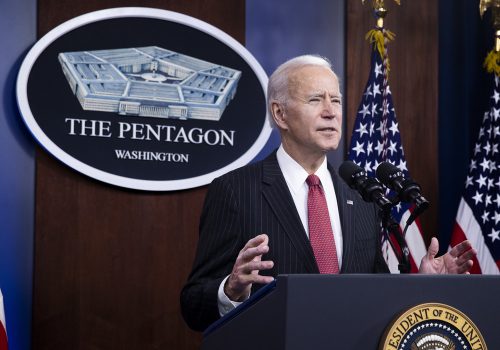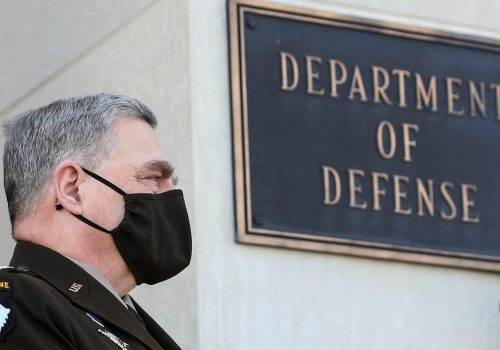What the US can learn from the UK about strategic reviews

The Biden administration has begun work on a slew of strategies—including a new National Security Strategy, National Defense Strategy, and Nuclear Posture Review—that will form the framework for its approach to evolving and diversifying security challenges. The documents will seek to strike a balance between the United States’ extensive mission in the world and the limits of its resources. It is a difficult task, made easier by the fact that the new US administration is not alone in this endeavor: There’s a lot that it can learn from the British experience of conducting strategic reviews.
In 2010, the British government decided to follow the United States in establishing a cycle of regular strategic reviews. It committed to conducting these every five years near the start of each parliamentary term. The first Strategic Defence and Security Review (SDSR) was published in October 2010; the second was released in November 2015; and an Integrated Review of Security, Defence, Development and Foreign Policy, delayed by the pandemic, is due for publication imminently (to be followed one week later by a defense strategy document with further detail on defense investments).
The United States should consider following the United Kingdom’s practice of addressing international security and homeland security together. The United Kingdom’s 2010 National Security Strategy and SDSR was the first whole-of-government security review. This reflected the experience of the first decade of the twenty-first century and the prioritization of threats from international terrorism, risks arising from failing and fragile states, and lessons from the grueling stabilization campaigns in Iraq and Afghanistan. These had shown the need to jointly address defense, diplomacy, and development (the three Ds) alongside homeland security.
The interconnectedness of international security and homeland security became even clearer as great-power competition reemerged over the course of the 2010s. Great powers are conducting this competition largely through gray-zone activities (spreading disinformation, carrying out cyberattacks, engaging in subversion, etc.) that fall below the threshold of military conflict. Crucially, these activities often occur within the borders of other great powers or those powers’ allies and partners, transforming international threats into homeland-security concerns. A coherent security and defense strategy for the United States must deter and contain such activities wherever they occur—whether within or beyond US borders.
The United States should also draw upon the United Kingdom’s comprehensive approach to security planning, which addresses military and other security threats (and responses) in one integrated document. Given how all these issues are deeply intertwined in the contemporary strategic environment, this is the most appropriate approach to defense and security strategy. Not every threat and response can be considered in the same depth in a comprehensive security plan—and some topics (like defense) have to be unpacked in subsidiary documents given their inherent complexity. Even so, a single, comprehensive review ensures that all subsidiary documents are properly and sequentially aligned with overall security and defense goals.
Addressing these issues together, however, is not straightforward. The United Kingdom’s first attempt in 2010 was not widely applauded, partly because the review was conducted very quickly and in fiscally strained circumstances after the 2008 Global Financial Crisis. The 2015 SDSR was more compelling in this regard, and the current Integrated Review, as its title suggests, aims to take the approach further.
The United States should consider developing criteria or tests as well to help assess the results of strategic reviews and the processes that generated them. This would help answer a deceptively simple question that inevitably arises with set-piece strategy documents and reviews: Once the strategy is finalized, but before it faces the verdict of major events, how can Congress and the administration assess whether the right conclusions and right decisions were reached?
As former senior UK Ministry of Defence officials, we (along with a third colleague) have proposed five tests by which recent British reviews and the upcoming Integrated Review can be assessed. These tests could, by extension, help assess the United States’ reviews and guide the new administration’s decisions on defense policy. The tests should evaluate the following:
- The risk and threat assessment and the resulting policy baseline: In hindsight, how plausible were the review’s assessments of how the threats and risks to national security might evolve? How well did they then inform the policy baseline?
- Policy and planning responses: How relevant and how successful over time were the review’s key national-security, defense-policy, and defense-planning responses?
- Capability and force structure outcomes: In hindsight, did the reviews inspire the right adjustments to capability and force structures? What are the major adjustments and choices that will be suggested in upcoming strategic reviews and how do they compare with those in previous reviews?
- Shape of the budgetary settlement: What adjustments were made (and not made) to the defense budget in previous reviews? In hindsight, did the review balance policy imperatives and missions with available resources? How sustainable is this balance in upcoming reviews?
- Organization and systems: Did the organizational changes within the government and the armed forces suggested by previous reviews produce the desired effect? Do upcoming reviews propose organizations and processes that can handle the challenges ahead?
Past UK reviews generally scored relatively well on the tests regarding risk and threat assessment and policy and planning responses. They scored less well on the tests involving capability and force structure outcomes and organization and systems. They were too cautious in addressing, for example, the implications of proliferating drone and missile technologies. The reviews scored poorly with respect to the budget test; both the 2010 and 2015 SDSRs were followed by periods of significant budgetary strain.
We cannot yet predict how the upcoming Integrated Review will score on these tests, although the significant increase in the UK defense budget announced by the British government in November 2020 should earn the review better grades on the budget test. But these types of analyses could provide meaningful guidance for defense-policy decisions not just in the United Kingdom but also in the United States.
Given the accelerating pace of change in the security environment, the United Kingdom’s five-year cycle for strategic reviews feels generous. The British government has had to supplement major set-piece reviews with mini-reviews (e.g., the National Security Capability Review and Modernising Defence Programme of 2018) and it seems likely that there will be more in the future. The task is to strike a balance. While a five- or four-year cycle is too rigid, a state of continuous reviews is exhausting. Even though it has a regular cycle for creating its strategic reviews, the United States should consider matching the frequency and duration of its release of strategies and reviews to the pace of change in the security environment.
While the US security and defense enterprise operates on a different scale from the British one, it’s still possible for the two allies to learn from one another. As the United States enters its next strategic planning cycle, the Biden administration should reflect on the lessons from the United Kingdom’s experience. They underscore the value of adopting a more integrated approach for security and defense strategy—and clearly defining what constitutes success in creating strategies for a more challenging world.
Peter Watkins and Will Jessett were both senior officials in the UK Ministry of Defence who were involved in the United Kingdom’s Strategic Defence and Security Reviews of 2010 and 2015 as well as other strategic reviews. They are now nonresident senior fellows at the Atlantic Council.
Further reading
Image: Military servicemen look on during British troops of the NATO enhanced Forward Presence battle group based in Estonia, certification field tactical exercise in Adazi, Latvia June 18, 2020. REUTERS/Ints Kalnins



